Peugeot 308 2014 Owner's Manual
Manufacturer: PEUGEOT, Model Year: 2014, Model line: 308, Model: Peugeot 308 2014Pages: 400, PDF Size: 10.05 MB
Page 231 of 400
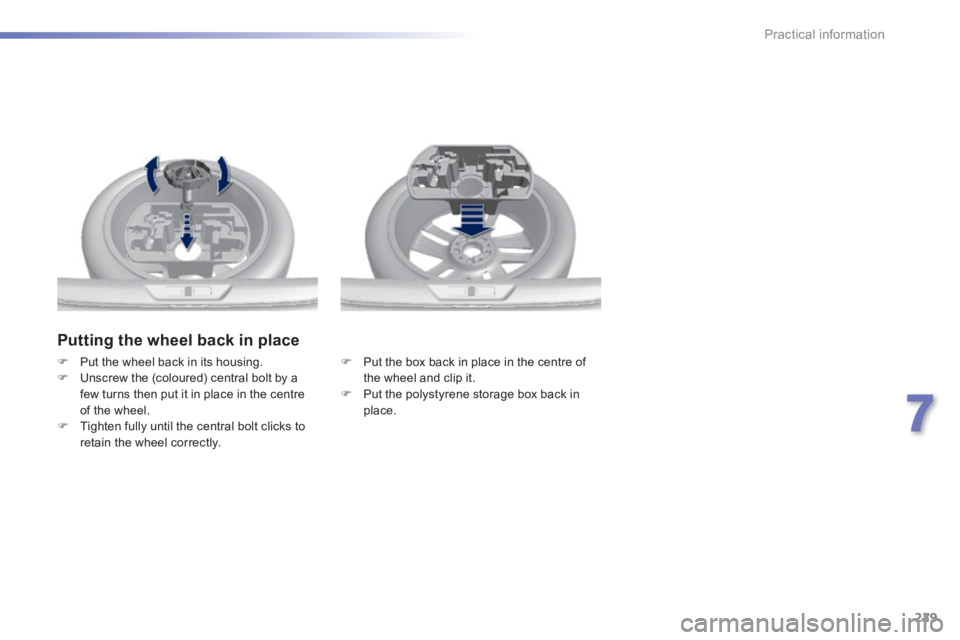
229
7
Practical information
308_EN_CHAP07_INFO PR ATIQUES_ED02-2013
Putting the wheel back in place
Put the box back in place in the centre of the wheel and clip it. Put the polystyrene storage box back in place.
Put the wheel back in its housing. Unscrew the (coloured) central bolt by a few turns then put it in place in the centre of the wheel. Tighten fully until the central bolt clicks to retain the wheel correctly.
Page 232 of 400
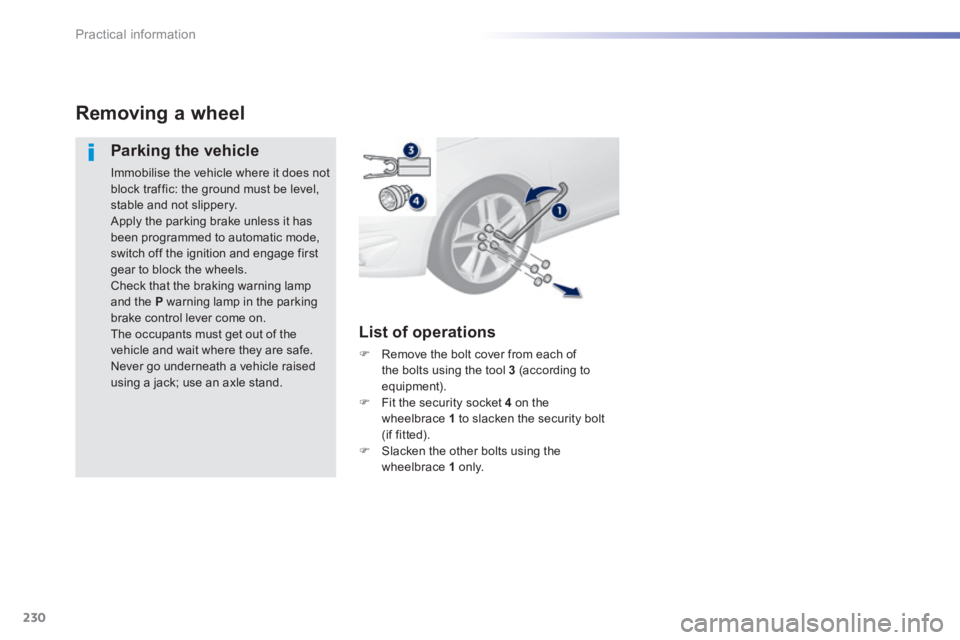
230
Practical information
308_EN_CHAP07_INFO PR ATIQUES_ED02-2013
Removing a wheel
Parking the vehicle
Immobilise the vehicle where it does not block traffic: the ground must be level, stable and not slippery. Apply the parking brake unless it has been programmed to automatic mode, switch off the ignition and engage first gear to block the wheels. Check that the braking warning lamp and the P warning lamp in the parking brake control lever come on. The occupants must get out of the vehicle and wait where they are safe. Never go underneath a vehicle raised using a jack; use an axle stand.
List of operations
Remove the bolt cover from each of the bolts using the tool 3 (according to equipment). Fit the security socket 4 on the wheelbrace 1 to slacken the security bolt (if fitted). Slacken the other bolts using the wheelbrace 1 o n l y.
Page 233 of 400
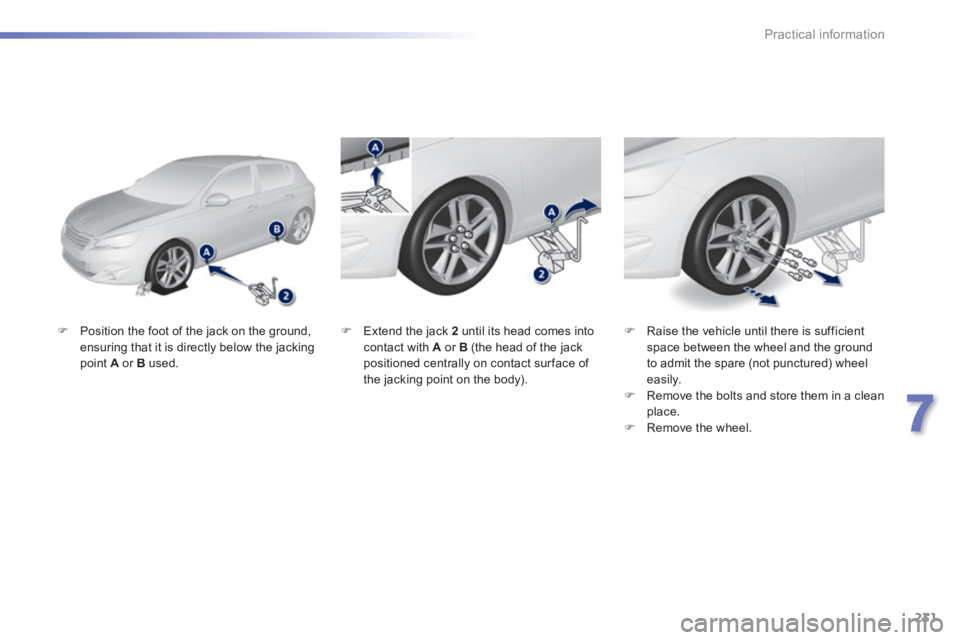
231
7
Practical information
308_EN_CHAP07_INFO PR ATIQUES_ED02-2013
Position the foot of the jack on the ground, ensuring that it is directly below the jacking point A or B used.
Raise the vehicle until there is sufficient space between the wheel and the ground to admit the spare (not punctured) wheel easily. Remove the bolts and store them in a clean place. Remove the wheel.
Extend the jack 2 until its head comes into contact with A or B (the head of the jack positioned centrally on contact sur face of the jacking point on the body).
Page 234 of 400
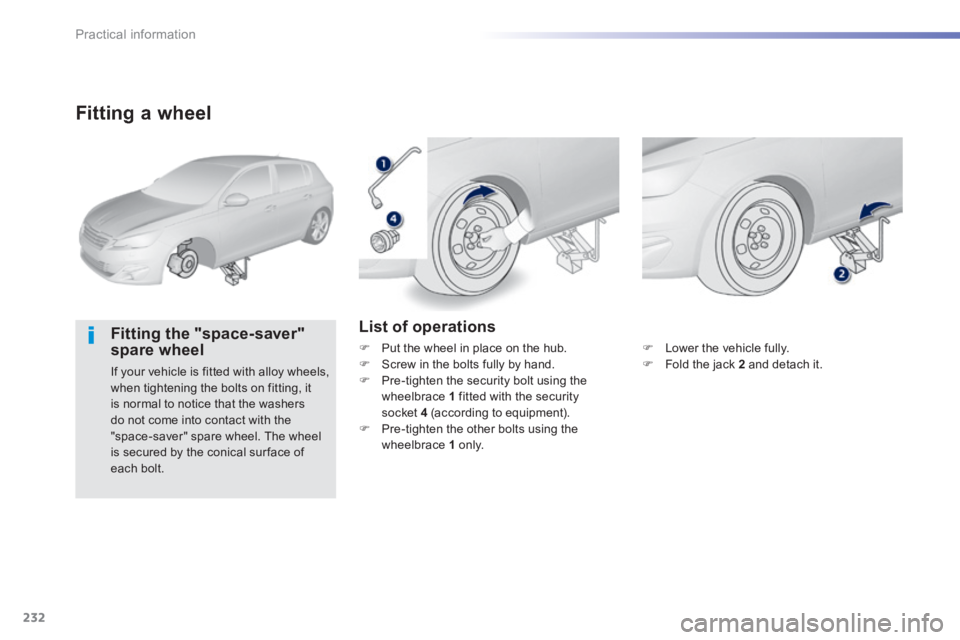
232
Practical information
308_EN_CHAP07_INFO PR ATIQUES_ED02-2013
Fitting a wheel
Fitting the "space-saver" spare wheel
If your vehicle is fitted with alloy wheels, when tightening the bolts on fitting, it is normal to notice that the washers do not come into contact with the "space-saver" spare wheel. The wheel is secured by the conical sur face of each bolt.
List of operations
Put the wheel in place on the hub. Screw in the bolts fully by hand. Pre-tighten the security bolt using the wheelbrace 1 fitted with the security socket 4 (according to equipment). Pre-tighten the other bolts using the
wheelbrace 1 o n l y.
Lower the vehicle fully. Fold the jack 2 and detach it.
Page 235 of 400
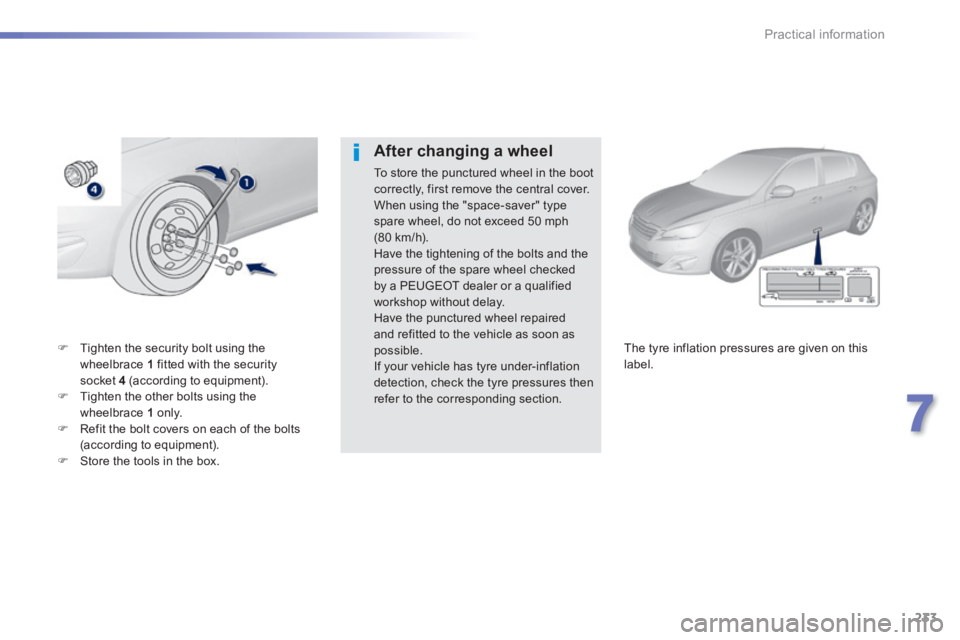
233
7
Practical information
308_EN_CHAP07_INFO PR ATIQUES_ED02-2013
Tighten the security bolt using the wheelbrace 1 fitted with the security socket 4 (according to equipment). Tighten the other bolts using the wheelbrace 1 o n l y. Refit the bolt covers on each of the bolts
(according to equipment). Store the tools in the box.
The tyre inflation pressures are given on this label.
After changing a wheel
To store the punctured wheel in the boot correctly, first remove the central cover. When using the "space-saver" type spare wheel, do not exceed 50 mph
(80 km/h). Have the tightening of the bolts and the pressure of the spare wheel checked by a PEUGEOT dealer or a qualified workshop without delay. Have the punctured wheel repaired and refitted to the vehicle as soon as possible. If your vehicle has tyre under-inflation detection, check the tyre pressures then refer to the corresponding section.
Page 236 of 400
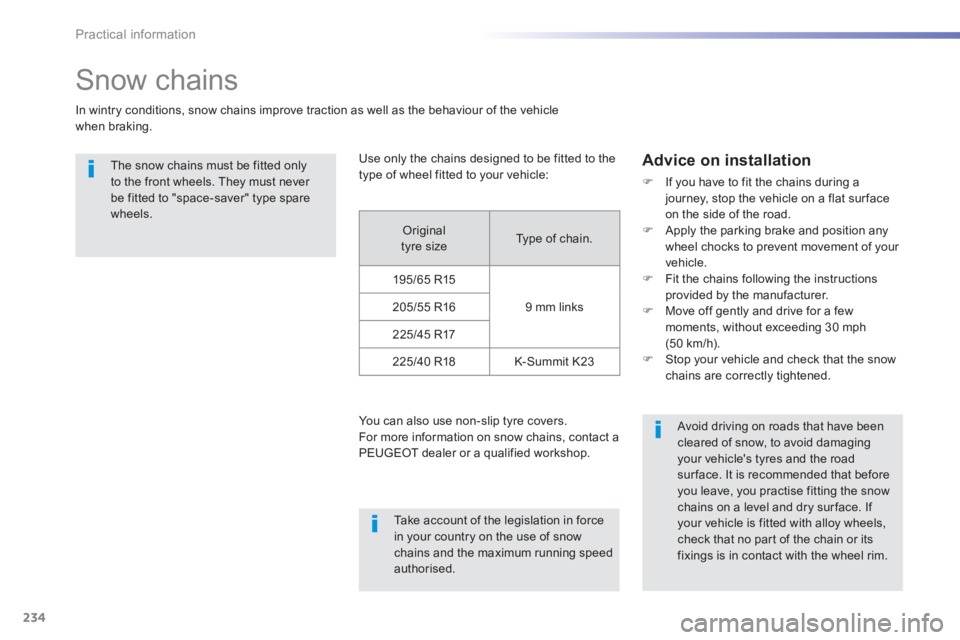
234
Practical information
308_EN_CHAP07_INFO PR ATIQUES_ED02-2013
Snow chains
In wintry conditions, snow chains improve traction as well as the behaviour of the vehicle when braking.
The snow chains must be fitted only to the front wheels. They must never be fitted to "space-saver" type spare wheels.
Take account of the legislation in force in your country on the use of snow chains and the maximum running speed authorised.
Avoid driving on roads that have been cleared of snow, to avoid damaging your vehicle's tyres and the road sur face. It is recommended that before you leave, you practise fitting the snow chains on a level and dry sur face. If your vehicle is fitted with alloy wheels, check that no part of the chain or its fixings is in contact with the wheel rim.
Use only the chains designed to be fitted to the type of wheel fitted to your vehicle:
You can also use non-slip tyre covers. For more information on snow chains, contact a PEUGEOT dealer or a qualified workshop.
Advice on installation
If you have to fit the chains during a journey, stop the vehicle on a flat sur face on the side of the road. Apply the parking brake and position any wheel chocks to prevent movement of your vehicle. Fit the chains following the instructions provided by the manufacturer. Move off gently and drive for a few moments, without exceeding 30 mph (50 km/h). Stop your vehicle and check that the snow chains are correctly tightened.
Original tyre size Type of chain.
195/65 R15
9 mm links 205/55 R16
225/45 R17
225/40 R18 K-Summit K23
Page 237 of 400
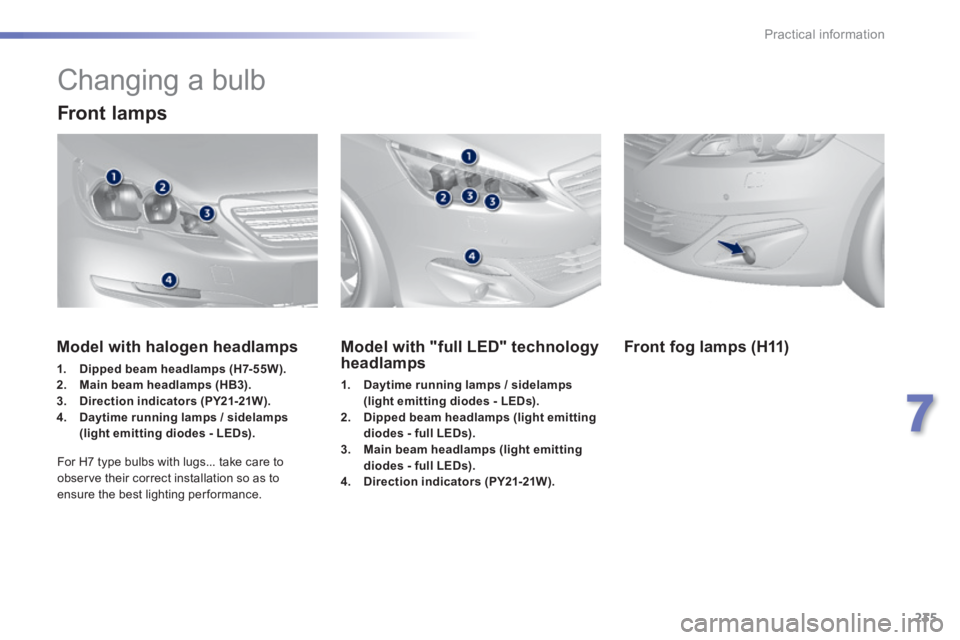
235
7
Practical information
308_EN_CHAP07_INFO PR ATIQUES_ED02-2013
Changing a bulb
Front lamps
Model with "full LED" technology headlamps
1. Daytime running lamps / sidelamps (light emitting diodes - LEDs).2. Dipped beam headlamps (light emitting diodes - full LEDs).3. Main beam headlamps (light emitting diodes - full LEDs).4. Direction indicators (PY21-21W).
Model with halogen headlamps
1. Dipped beam headlamps (H7-55W).2. Main beam headlamps (HB3).3. Direction indicators (PY21-21W).4. Daytime running lamps / sidelamps (light emitting diodes - LEDs).
For H7 type bulbs with lugs... take care to observe their correct installation so as to ensure the best lighting per formance.
Front fog lamps (H11)
Page 238 of 400
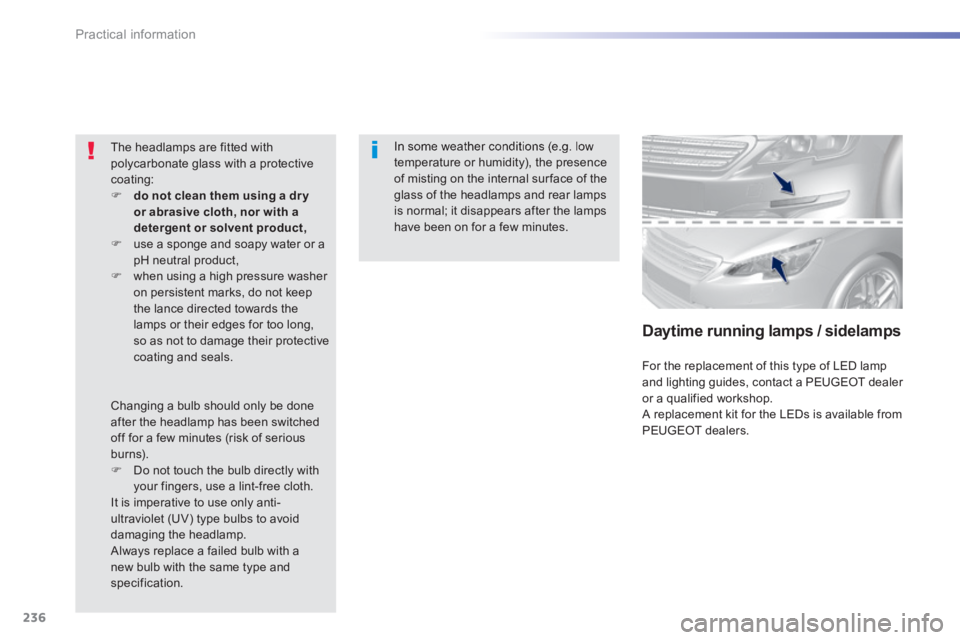
236
Practical information
308_EN_CHAP07_INFO PR ATIQUES_ED02-2013
In some weather conditions (e.g. low temperature or humidity), the presence of misting on the internal sur face of the glass of the headlamps and rear lamps is normal; it disappears after the lamps have been on for a few minutes.
The headlamps are fitted with polycarbonate glass with a protective coating: do not clean them using a dr y or abrasive cloth, nor with a detergent or solvent product, use a sponge and soapy water or a pH neutral product, when using a high pressure washer on persistent marks, do not keep the lance directed towards the lamps or their edges for too long, so as not to damage their protective coating and seals.
Changing a bulb should only be done after the headlamp has been switched off for a few minutes (risk of serious burns). Do not touch the bulb directly with your fingers, use a lint-free cloth. It is imperative to use only anti-ultraviolet (UV) type bulbs to avoid
damaging the headlamp. Always replace a failed bulb with a new bulb with the same type and specification.
Daytime running lamps / sidelamps
For the replacement of this type of LED lamp and lighting guides, contact a PEUGEOT dealer or a qualified workshop. A replacement kit for the LEDs is available from
PEUGEOT dealers.
Page 239 of 400
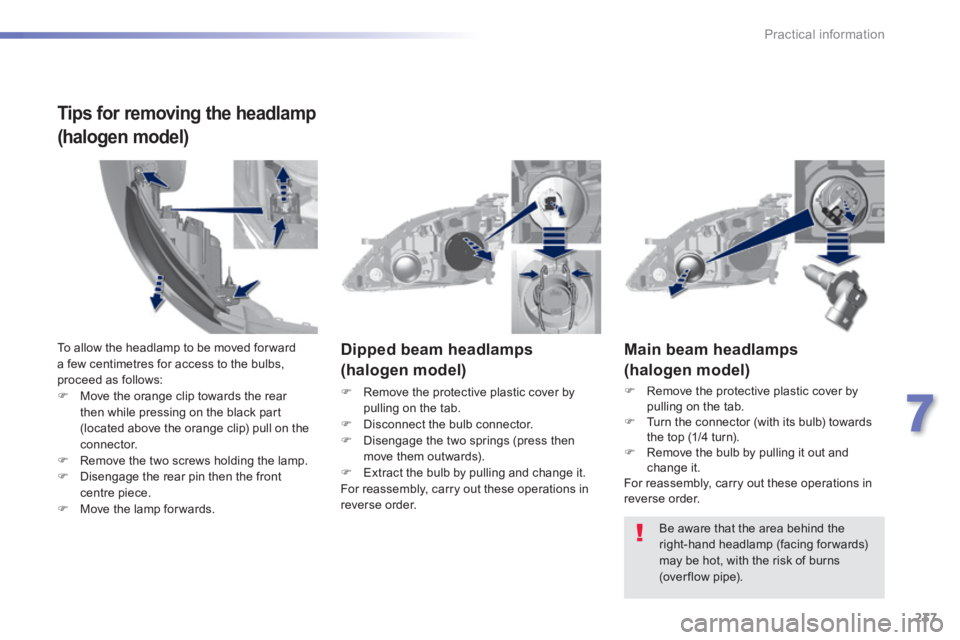
237
7
Practical information
308_EN_CHAP07_INFO PR ATIQUES_ED02-2013
Main beam headlamps
(halogen model)
Remove the protective plastic cover by pulling on the tab. Turn the connector (with its bulb) towards the top (1/4 turn). Remove the bulb by pulling it out and change it. For reassembly, carry out these operations in reverse order.
Dipped beam headlamps
(halogen model)
Remove the protective plastic cover by pulling on the tab. Disconnect the bulb connector. Disengage the two springs (press then move them outwards). Extract the bulb by pulling and change it. For reassembly, carry out these operations in reverse order.
Be aware that the area behind the right-hand headlamp (facing forwards) may be hot, with the risk of burns (over flow pipe).
To allow the headlamp to be moved for ward a few centimetres for access to the bulbs, proceed as follows: Move the orange clip towards the rear then while pressing on the black part (located above the orange clip) pull on the
connector. Remove the two screws holding the lamp. Disengage the rear pin then the front centre piece. Move the lamp for wards.
Tips for removing the headlamp
(halogen model)
Page 240 of 400
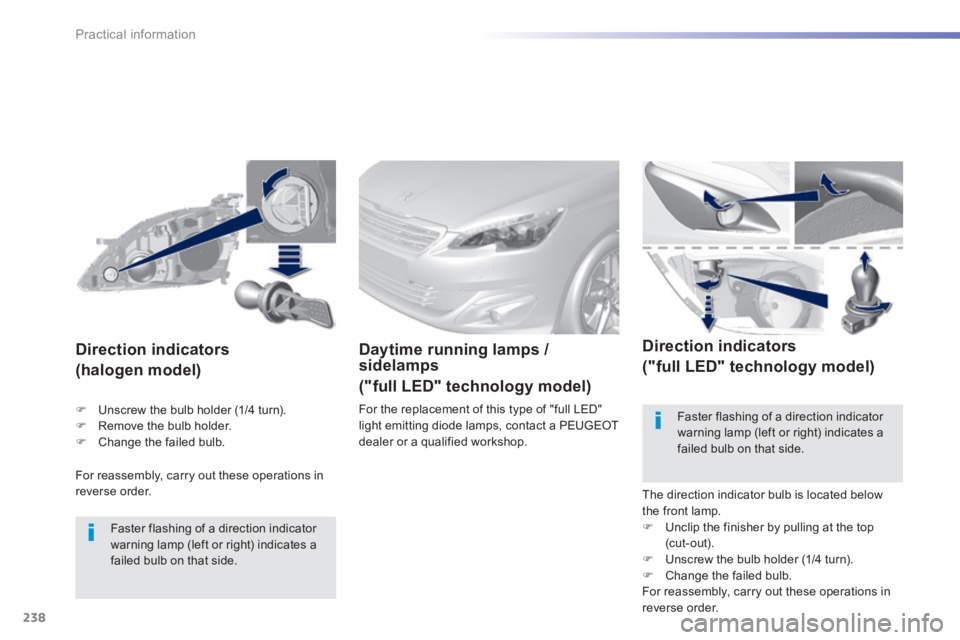
238
Practical information
308_EN_CHAP07_INFO PR ATIQUES_ED02-2013
For reassembly, carry out these operations in reverse order.
Direction indicators
(halogen model)
Faster flashing of a direction indicator warning lamp (left or right) indicates a failed bulb on that side.
Daytime running lamps / sidelamps
("full LED" technology model)
For the replacement of this type of "full LED" light emitting diode lamps, contact a PEUGEOT dealer or a qualified workshop.
Direction indicators
("full LED" technology model)
The direction indicator bulb is located below the front lamp. Unclip the finisher by pulling at the top (cut-out). Unscrew the bulb holder (1/4 turn). Change the failed bulb. For reassembly, carry out these operations in reverse order.
Faster flashing of a direction indicator
warning lamp (left or right) indicates a failed bulb on that side.
Unscrew the bulb holder (1/4 turn). Remove the bulb holder. Change the failed bulb.